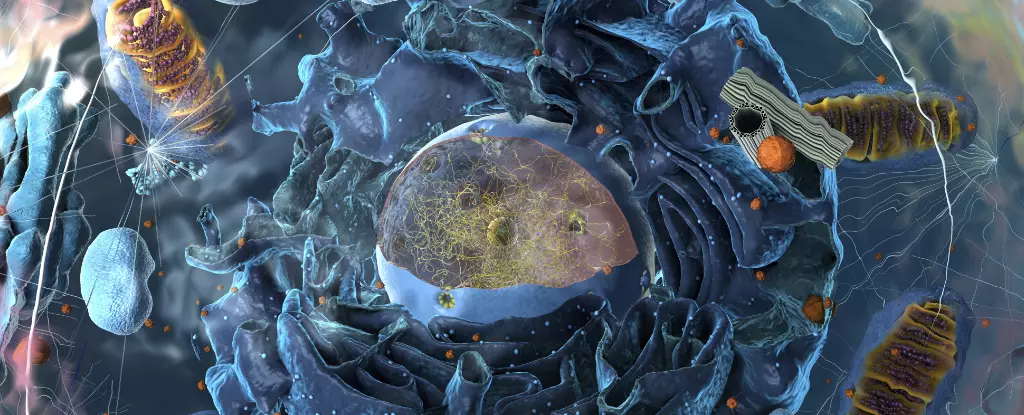Cells are often depicted as highly organized units, streamlined by textbook diagrams that showcase distinct compartments known as organelles. Traditionally, these organelles have often been characterized by their membrane-bound structures—like mitochondria, the powerhouse of the cell, and lysosomes, the waste recyclers. However, a seismic shift in our understanding of cellular architecture occurred in the mid-2000s with the discovery of biomolecular condensates, or membraneless organelles. This newfound awareness has not only altered our perspective on the inner workings of cells but has also stirred debates regarding the very principles of biology and the origins of life.
Once simply dismissed as mere cellular debris, biomolecular condensates have emerged as key players in cellular activities. These gel-like droplets formed by aggregates of proteins and RNA hold the secret to a dynamic and adaptable form of cellular organization. To visualize these condensates, one might imagine the mesmerizing motion of a lava lamp, where blobs of wax coalesce and separate in a dance of fluidity. Much like that wax, certain proteins and RNA strands preferentially engage with each other, leading to the formation of these unique microenvironments that facilitate biochemical processes within the cell.
As of 2022, the scientific community has identified about 30 varieties of these membraneless organelles, far outnumbering their traditional membrane-bound counterparts. This diversification hints at complex roles and functions that have yet to be fully unraveled. For instance, while some condensates are recognized for functions like contributing to stress response or ribosome assembly, the purpose of many others remains elusive, presenting fertile ground for future research.
At the core of biomolecular condensate research is a reconsideration of longstanding views regarding protein structures. Historically, a strong correlation has existed between a protein’s shape and its function—known as the structure-function paradigm. Proteins have been understood primarily through their well-defined geometric forms. However, a subset of proteins, known as intrinsically disordered proteins (IDPs), challenges this dogma.
identified in the early 1980s, these IDPs lack a rigid structure yet play essential roles within cellular contexts, often coalescing into biomolecular condensates. This revelation raises profound questions about the relationship between structure and function; it highlights a layer of complexity and variability inherent in cell biology that was previously overlooked. Understanding the exact roles of these intrinsically disordered proteins in the formation and functionality of condensates could pave the way for breakthroughs in molecular biology.
Further complicating matters is the discovery of biomolecular condensates in prokaryotic organisms, which have historically been viewed as simpler than their eukaryotic counterparts due to the absence of membrane-bound organelles. The presence of such condensates in bacteria signifies a paradigm shift in our understanding of these single-celled organisms, suggesting that they possess a level of sophistication unrecognized until now.
With only about 6 percent of bacterial proteins identified as lacking structural order, the presence of biomolecular condensates in prokaryotic life forms challenges previous conceptions of their biological capabilities. Researchers have found that these condensates play crucial roles in various cellular processes, including RNA synthesis and degradation, revealing that bacterial cells are not merely “bags of proteins” but complex systems capable of diverse biochemical functions.
Insights Into the Origins of Life
The reverberations of discovering biomolecular condensates extend to fundamental questions regarding the origins of life on Earth. Traditionally, the formation of cellular life has been assumed to necessitate membrane encapsulation, intimating a requirement for lipid synthesis—something likely absent on primordial Earth. However, if RNA molecules can aggregate into biomolecular condensates autonomously, it opens new avenues for understanding how abiotic chemistry could lead to life.
The RNA world hypothesis, which posits that the earliest life forms were RNA strands, gains traction through these findings. If condensates can facilitate the organization and replication of these strands, the pathway from nonliving chemicals to living entities becomes all the more plausible, reshaping our narratives about life’s inception.
Transforming Biomedical Approaches
The burgeoning field of biomolecular condensate research is not just ivory-tower theorizing. Its implications reach into the realm of human health and diseases like Alzheimer’s, Huntington’s, and amyotrophic lateral sclerosis (ALS). Scientists are actively exploring how to manipulate these condensates for therapeutic applications, potentially yielding drugs capable of promoting or dissolving condensates for disease intervention.
As our understanding grows, we can anticipate a future where each type of biomolecular condensate may be linked to specific functionalities, enriching the educational curriculum for biology students everywhere. The possibilities presented by this exciting frontier in cellular biology hold the potential to redefine both theoretical frameworks and practical applications in science, ushering in a new era of insight into the complexities of life.

